Military Freefall Parachutist Badge
| Military Freefall Parachutist Badge | |
|---|---|
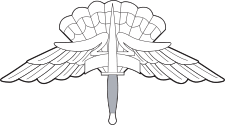 | |
| Awarded by U.S. Army and U.S. Air Force | |
| Type | Badge |
| Awarded for | Qualification as a high-altitude parachutist |
| Status | Currently awarded |
| Statistics | |
| First awarded | 1 October 1994[1] |
| Last awarded | On going |
| Precedence | |
| Next (higher) | Parachute Rigger Badge |
| Next (lower) | Army Aviator Badges[2] |
The Military Freefall Parachutist Badge is a military badge of the United States Army and United States Air Force awarded to qualified U.S. Army and U.S. Air Force personnel as high-altitude military parachute specialists.[2][3][4]
Qualifications
To earn the Military Freefall Parachutist Badge, the military member first must receive all necessary ground training, already have earned the Military Parachutist Badge (jump-qualified), and must have completed the requisite freefall (night, combat equipment, oxygen) jumps and graduate from the Military Free-Fall Parachutist Course.[5]
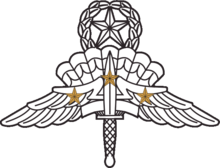
A star and laurel wreath, centered above the badge, called the Master Military Freefall Parachutist Badge, is authorized for U.S. Army Soldiers and U.S. Air Force Airman qualified as a Master Military Freefall Parachutist (Jumpmaster). Such qualification requires completing the Military Free-Fall Jumpmaster Course, wherein the student learns how to be a jumpmaster in military freefall operations.[1][6]
As with the U.S. Army's Military Parachutist Badge, small bronze and gold stars are placed on the badge to represent participation in combat jumps, known as Combat Jump Devices, and can be awarded with either the basic and master versions of the badge. To earn the device, a Military Freefall Parachutist must have conducted a High-altitude/low-opening (HALO) or high-altitude/high-opening (HAHO) jump in a war zone. The stars are awarded as follows:[7]
| One combat jump | A bronze star centered on the dagger |
| Two combat jumps | A bronze star on each wing |
| Three combat jumps | A bronze star on each wing and one star centered on the dagger |
| Four combat jumps | Two bronze stars on each wing |
| Five or more combat jumps | A gold star centered on the dagger |
History
The Military Freefall Badge original design was submitted in March 1983 by Sergeant First Class Gregory A. Dailey of SFODA-552, Company B, 2nd Battalion, 5th Special Forces Group. Updates on the design, adding a Master Military Freefall Parachutist Badge were submitted by General Wayne A. Downing of U.S. Special Operations Command (USSOCOM) and James Phillips of the Special Forces Association. The badge was approved for wear by U.S. Army Soldiers assigned to U.S. Army Special Operations Command (USASOC) on 1 October 1994. Unrestricted wear was approved on 7 July 1997 by General Dennis Reimer.[1]
Symbolism of the badge's design:[1]
- The dagger is a Fairbairn-Sykes Fighting Knife, used by the Office of Strategic Services during World War II, and represents infiltration techniques.
- The arched tab represents tabs worn by special operations forces.
- The parachute is a seven-celled MT1-X, the first ram-air parachute to be adopted by the U.S. Military as the standard freefall canopy.
- The wings represent flight and airborne capabilities.
Training
Early U.S. Army Special Forces HALO training at Fort Gulick, circa 1966
|
The U.S. Military Free-Fall School (MFFS) is operated by the USASOC's John F. Kennedy Special Warfare Center and School, 1st Special Warfare Training Group (Airborne), 2nd Battalion, Company B at the U.S. Army's Yuma Proving Ground (YPG) in Arizona, which is the USSOCOM proponent for military freefall.[8][9] The MFFS conducts three primary training courses, the Military Free-Fall Parachutist Course, the Military Free-Fall Jumpmaster Course, and the Military Free-Fall Advanced Tactical Infiltration Course.[9] The U.S. Air Force also conducts the Military Free-Fall Jumpmaster Course, certified by USSOCOM and the MFFS, at Davis–Monthan Air Force Base for airman that are not able to attend the MFFS's jumpmaster course.[10] Alternatively, detachments from the MFFS conduct the Military Free-Fall Jumpmaster Course via mobile training teams (MTT) for military freefall units that have difficulty attending the course at the Yuma Proving Ground.[11]
.jpg)
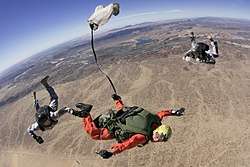
The Military Free-Fall Parachutist Course (MFFPC) is open to special operations forces assigned to military freefall coded positions, parachute riggers, and select DoD civilian personnel or allied personnel assigned to military freefall positions. To attend MFFPC, students must have graduated from the U.S. Army Airborne School and must meet specific medical requirements. Week one of the four-week course focuses on vertical wind tunnel body stabilization training, parachute packing, and an introduction to military freefall operations. The remaining weeks focuses training on varying jump profiles using three airborne operations per training iteration, totaling 30 military freefall operations per course encompassing various conditions and equipment loads. At the end of the course, students will have learned how to:[5]
- Pack the RA-1 Military Free-Fall Advanced Ram-Air Parachute System main parachute and don the system
- Rigging/jumping procedures for weapons, combat equipment, night vision goggles and portable oxygen equipment
- Aircraft procedures
- Exit an aircraft from the door and ramp using dive and poised exit positions
- Emergency procedures and body stabilization
- HALO and HAHO parachute jumps from altitudes of 10,000 ft (3,048 m) to 25,000 ft (7,620 m)
Upon graduation of the MFFPC, students are awarded the Military Freefall Parachutist Badge.

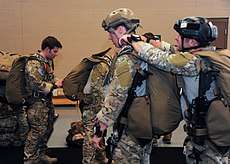

To attend the Military Free-Fall Jumpmaster Course (MFFJMC), students must have graduated from the U.S. Army Airborne School, the MFFPC, the U.S. Army Jumpmaster School, be a current military freefall parachutist, served as a military freefall parachutist for a minimum of one year, and must have completed at least 50 military freefall jumps. The three-week MFFJMC focuses on training students on jumpmaster duties and responsibilities, such as:[6]
- Nomenclature
- Jumpmaster personnel inspection
- Emergency procedures
- Oxygen equipment
- Wind drift calculations
- Altimeter calculations
- Emergency automatic activation device calculations
- Jump commands
- Aircraft procedures
- Techniques of spotting
- HAHO techniques
- Ram-air parachute system packing and rigging
Upon graduation of the MFFMJC, students are awarded the Master Military Freefall Parachutist Badge.

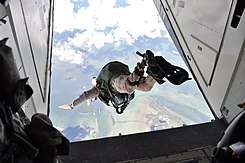
To attend the Military Free-Fall Advanced Tactical Infiltration Course (MFFATIC), students must have the same qualifications and completed the same prerequisites required of the MFFJMC. The three-week MFFATIC focuses on educating and training joint special operations forces and other selected personnel in the planning and conduct of night military freefall tactical infiltrations as a group onto unknown and unmarked drop zones. Training includes:[12]
- Following GPS guided bundles
- Carrying combat equipment
- Communications
- Wearing night vision devices
- Non-standard weapons while using oxygen equipment
- Utilization of various parachutist navigational devices
Upon graduation of the MFFATIC, students are presented a certificate of completion; there is no badge or badge device awarded for completion of the MFFATIC.
See also
- No. 1 Parachute Training School RAF
- Parachute Training School (Australian Army)
- Parachute Training School (Pakistan Army)
- United States Army Parachute Team
- United States Army Maneuver Center of Excellence Command Exhibition Parachute Team
- United States Special Operations Command Parachute Team
- "Blood on the Risers"
- United States Army Reconnaissance and Surveillance Leaders Course
References
- 1 2 3 4 "Military Free Fall Parachute Badge". Army Quartermaster Museum. United States Army. Retrieved 2008-11-22.
- 1 2 Army Regulation 600-8-22 Military Awards (24 June 2013). Table 8-1, U.S. Army Badges and Tabs: Orders of precedence. p. 120 Archived 17 October 2013 at the Wayback Machine.
- ↑ Army Regulation 670-1, Wear and Appearance of Army Uniforms and Insignia Archived 2015-04-06 at the Wayback Machine., dated 3 February 2005, revised 11 May 2012, accessed 1 June 2012
- ↑ AFI 11-402, Aviation and Parachutist Service, Aeronautical Ratings and Badges Archived 2014-01-12 at the Wayback Machine., U.S. Air Force Instructions, dated 13 December 2010, last accessed 11 January 2014
- 1 2 MFFPC ATRRS Information Changes, U.S. Army Special Operations Center of Excellence, last accessed 22 April 2017
- 1 2 Military Free-Fall Jumpmaster Course (MFFJMC), U.S. Army Special Operations Center of Excellence, last accessed 22 April 2017
- ↑ Qualification Badges, Military Free Fall Parachutist Badge, United States Army Institute of Heraldry, last accessed 22 April 2017
- ↑ Special Forces Qualification Course to incorporate military free-fall training, Army.mil, by MAJ James Branch (USA), dated 4 October 2012, last accessed 22 April 2017
- 1 2 1st Special Warfare Training Group (Airborne), U.S. Army Special Operations Center of Excellence, last accessed 22 April 2017
- ↑ Mastering the jump, Davis-Monthan Air Force Base official page, by Airman Nathan H. Barbour, dated 1 July 2016, last accessed 22 April 2017
- ↑ Talley, LCpl Jordan (21 April 2017). "First Ever Military Freefall Jumpmaster Course Hosted Overseas". dvids. Camp Courtney. Retrieved 21 May 2017.
- ↑ Military Free-Fall Advanced Tactical Infiltration Course (MFFATIC), U.S. Army Special Operations Center of Excellence, last accessed 22 April 2017